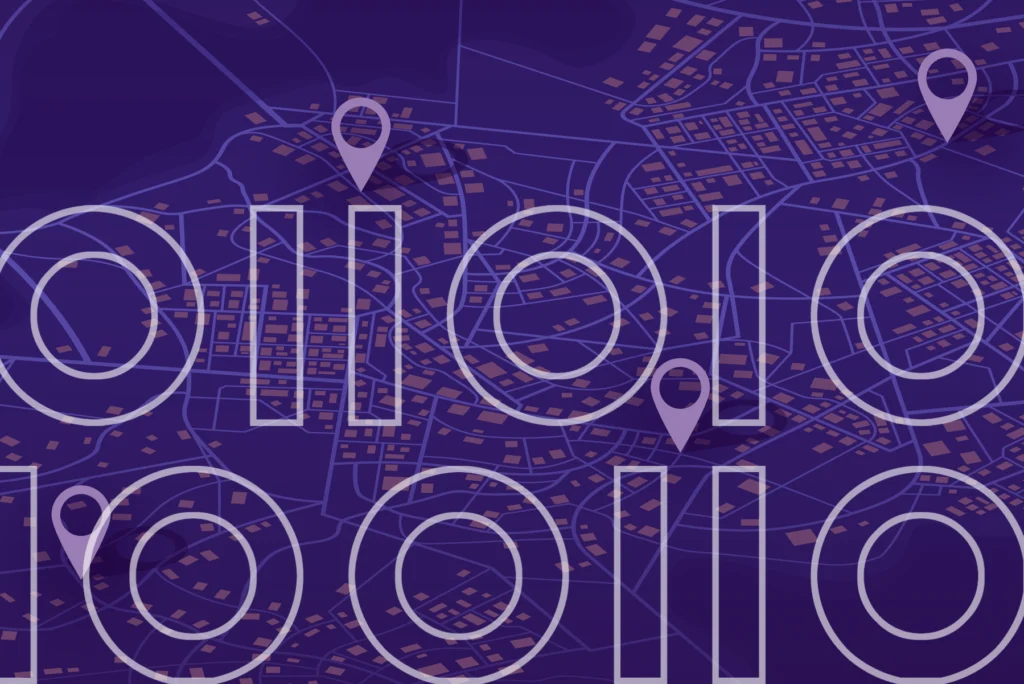In recent years, two important technology trends have converged: big data analytics and location intelligence. Big banks, telecommunications companies, global retailers, insurance companies, and healthcare organizations have all tapped into this combination of big data and location to gain new insights into the customers and constituents they serve. As the technology becomes more pervasive and as data science skills become more broadly available, more businesses and organizations are inevitably recognizing the strategic advantage of using location-based data to inform better business decisions.
Data, data, everywhere…
As the name suggests, big data begins with large volumes of information. Mobile devices, the Internet of things (IoT), and the proliferation of ecommerce and other online activities have resulted in a massive acceleration in the quantity of data generated in the world. In fact, over 90 percent of the data that exists in the world today was generated in the past two years.
A decade ago, managing and analyzing that volume of data was out of reach for all but a few of the largest companies. Computing power was a fraction of what it is today. Cloud interconnectivity has exploded, though, and the range and scope of data management and data analysis tools has expanded significantly. As cloud computing, integration, and other ingredients for big data analysis have converged, a new generation of data science experts is entering the workforce. AI and machine learning have matured to the point that they are accessible and usable for a wider audience than ever before.
The IBM PC democratized and revolutionized the use of computers in the 1980s, unleashing a giant leap forward in productivity and a transformation in the way we work. Likewise, big data, AI/machine learning, and the proliferation of data are coming together to democratize and revolutionize the process of improving our understanding of how the world works. Location data provides a critically important piece of that puzzle.
Velocity
Alongside this shift to the cloud and the proliferation of data, we see an increase in the velocity of data flows. Data silos have been broken down and it has become cheaper and easier to exchange data freely across the Internet. As a result, data is now becoming available faster than ever before. With this massive increase in volume, data quality has arisen as a concern and has come into greater focus.
Two decades ago, most of the activity on the Internet still consisted of browser-based traffic. Much of that was delivered over slow dial-up connections. Today, the Internet has transformed into a platform for the exchange of information, for delivering applications, and for serving up audio and video content. An array of data integration tools has made it possible to stream data between a variety of different data sources, securely and with virtually no delay. With that much connectivity, the velocity of information exchange has skyrocketed.
eBook
Location Intelligence for the Cloud
Most firms have trouble extracting value from the location data they collect. Learn how you can accelerate geospatial insights within cloud-native and big data environments for location intelligence in the cloud.
Variety
Finally, we see a vast increase in the variety of information that is available. Mobile phones and IoT devices, in particular, have introduced an array of new data points that can enrich analysis and create new opportunities for insight.
The real magic happens when we combine information from this variety of different sources. This is where location context shows its highest potential. Virtually every piece of data in the world can be associated with location in some way. Until recently, we had very little capacity to record most of that information or to put it to use. Today, we can, and smart companies are already doing it.
Adding value to your data
Decision-makers in the business world have been segmenting target-market populations for years. In the old days, they were limited to the little information they could collect, for example, by looking at statistical samples intended to understand the age, gender, and economic status of the people buying their products.
As we expand the number of data points, we can gain a much deeper appreciation of our target audience. We can predict, for example, that someone who subscribes to Better Homes & Gardens magazine is likely to spend more on home furnishings and garden products than the rest of the population. Even that, however, provides only a narrow glimpse into the life of our target demographic. When we add more contextual data, the value of the results increases exponentially.
Today, we have more information about target customers than ever before. Each new data point adds context, such that the whole is greater than the sum of its parts. Let’s assume for example, that a bank starts with the knowledge of where its customers live. The bank can easily add some location data that reflects ATM usage by those customers. By adding external data that reflects the commuting patterns of that population, they can gain an even better understanding of the places those customers frequent on a regular basis.
By leveraging the location of potential customers and comparing that to their existing customer base, branch locations, and competitor locations, the bank can gain a detailed understanding of where new opportunities exist. Where are the underserved customers? Do mobility trends indicate a whitespace in the market that no one has recognized before? Do commuting patterns indicate ideal locations for the placement of billboards or other advertising?
Using location intelligence and doing spatial analysis can help you determine which of your potential customers are in a catchment area for your services. By geo-enriching and tagging a customer record with this information, businesses can see which customers need to be targeted and when to do so.
The use cases for location intelligence (LI) are not limited to marketing, however. Insurance companies have used LI with detailed property information to better understand risk. Employers have used it to more effectively recruit talent in key areas. Government agencies have used LI to better address the needs of vulnerable populations. Retailers have used it for site selection and management.
Each new location-based data point adds a layer of context that enriches the potential benefits that big data analytics and AI have to offer. Few business leaders have yet realized just how much data is available to geo-enrich existing company data to yield disproportionately better insights. By adding geographical context to your existing data, you open up new possibilities for insights and innovation.
Precisely offers a wide spectrum of location-based software and data resources. Read our eBook to learn how you can accelerate geospatial insights within cloud-native and big data environments for location intelligence in the cloud.







